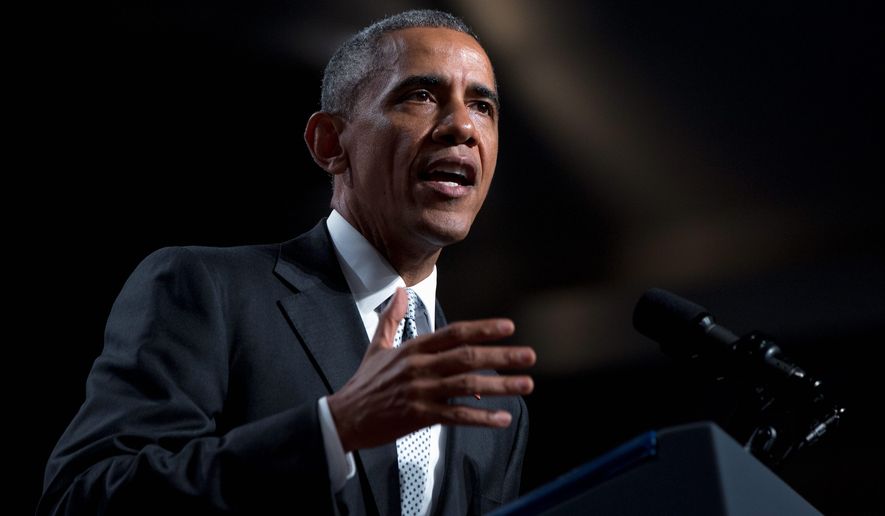With Barack Obama’s legacy on health care seemingly secure after last week’s landmark Supreme Court decision, the president’s ambitious environmental agenda will come into sharper focus — but a host of legal challenges and growing defiance across the country threaten his efforts to fight climate change.
The Supreme Court this week halted the administration’s mercury and air toxin standards, part of Mr. Obama’s broader plan to reduce pollution from U.S. power plants. In its 5-4 decision, the court said the Environmental Protection Agency disregarded the estimated $10 billion cost to utilities to comply with the measure.
The ruling dealt a major blow to Mr. Obama’s effort to ween the U.S. off of fossil fuels, and legal analysts say other pieces of the president’s environmental slate also are vulnerable in court. Among them is the EPA’s Clean Power Plan, which would dramatically limit carbon emissions from power plants.
Outside the courtroom, the president’s climate change program faces an equally murky future.
Indiana Gov. Mike Pence, a Republican, started last week what analysts say may become a trend. He said his state will ignore the EPA carbon regulations to insulate its residents from higher energy bills.
Federal data have confirmed that the EPA’s carbon rules for existing power plants will raise residential electricity bills.
“If your administration proceeds to finalize the Clean Power Plan, and the final rule has not demonstrably and significantly improved from the proposed rule, Indiana will not comply. Our state will also reserve the right to use any legal means available to block the rule from being implemented,” Mr. Pence said in a letter to the president. “Energy policy should promote the safe, environmentally responsible stewardship of our natural resources with the goal of reliable, affordable energy. Your approach to energy policy places environmental concerns above all others.”
The administration this week once again is zeroing in on climate change, a top priority for Mr. Obama during his final 18 months in office.
Mr. Obama and Brazilian President Dilma Rousseff announced Tuesday that their countries would work to increase renewable energy use over the next 15 years.
By 2030, each nation aims to get 20 percent of its electricity from renewable sources other than hydropower. The U.S. currently gets 7 percent of its power from renewable sources.
“These are very ambitious goals, a near tripling for the United States and more than double Brazil’s current output. This shows that the world’s major economies can begin to transcend some of the old divides and work together to confront the common challenge that we face, something that we have to work on for future generations,” Mr. Obama said during a press conference Tuesday alongside Ms. Rousseff.
The administration says it can hit the target because utilities will be forced to turn to renewable energy after the Clean Power Plan goes into effect and necessitates a move away from coal.
Under the plan, the final version of which is due this summer, states would be responsible for hitting EPA emission targets, and the closures or conversions of coal-fired plants are the only realistic ways to meet those goals.
Legal analysts say the Clean Power Plan also could run into trouble in court, and the proposal is even more problematic in some ways than the mercury standards struck down this week.
“I think the Clean Power Plan, if it stays in its current form, is much more vulnerable to the Supreme Court striking it down than even the [mercury standards]. You’ve got a very broad, sweeping change in not only CO2 emissions from power plants but also the way the grid operates,” said Jay Holloway, a lawyer at the firm Sutherland Asbill & Brennan LLP who specializes in environmental issues. “That’s a much bigger and much broader approach that the EPA is taking, and so the questions become numerous with respect to not only the unreasonableness of the EPA’s decision-making and the basis for the Clean Power Plan, but also its authority to make all of these changes.”
A coalition of states and energy companies already have brought lawsuits against the EPA over the proposal, but a federal appeals court tossed the case this month, saying the rules can’t be challenged until they are finalized. Critics have promised to file legal challenges once the final Clean Power Plan is unveiled.
At its core, the Clean Power Plan establishes tougher limits on carbon emissions and requires states to reduce pollution to such a degree that major investments in wind and solar power are necessary, as are expensive and largely unavailable technology to burn coal more cleanly.
Questions about those requirements likely would form the basis of inevitable legal challenges to the Clean Power Plan. Opponents contend that the EPA has gone far beyond its authority under the federal Clean Air Act.
Beyond the legal uncertainty, analysts say, the regulations could face increasing defiance across the country, particularly in states led by Republicans such as Mr. Pence.
“I think you’re going to see more of it. The problem with the Clean Power Plan is [the EPA] is telling the states to change their laws on a variety of things that are unrelated to the protection of the environment in order to meet this thing. There’s a lot of people who have become very upset with that,” said Dan Kish, senior vice president for policy at the conservative Institute for Energy Research.
• Ben Wolfgang can be reached at bwolfgang@washingtontimes.com.




Please read our comment policy before commenting.